Welbourn Hill Station
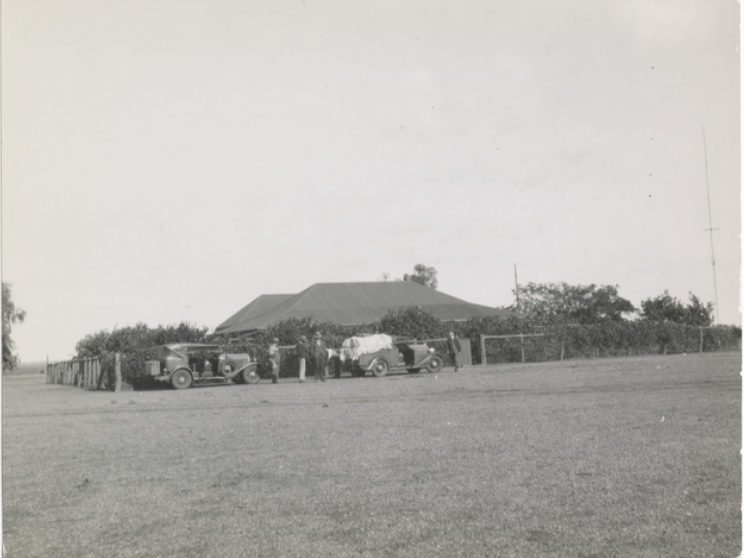
© Janet Lane, 2024. Image: View of the homestead at Welbourne Hill Station, South Australia. C. 1938, State Library S.A
In 1909 Welbourn Hill station was taken up by the father of Jack and Phil who later ran it, Mr W. Giles. Sadly, Mr Giles died in 1912, and Jack – who was only 19 – and his brother Phil took over running the station. This was soon interrupted when they both joined up in WW1. There were only about 100 head of cattle at that stage, and all was left in the hands of Mr Tom Williams. Luckily, Jack and Phil, after three and a half years at the war, made it back home.
Very little information online about this station re getting stock. However as surrounding stations had cattle and horses, it’s probable they were bought from those when taken up. Possibly some TB influence as they liked racing. They ran Shorthorns and Herefords. Therefore the bloodlines of Todmorden, Eringa and particularly Lambina in the time of horse days would be similar if not the same really.
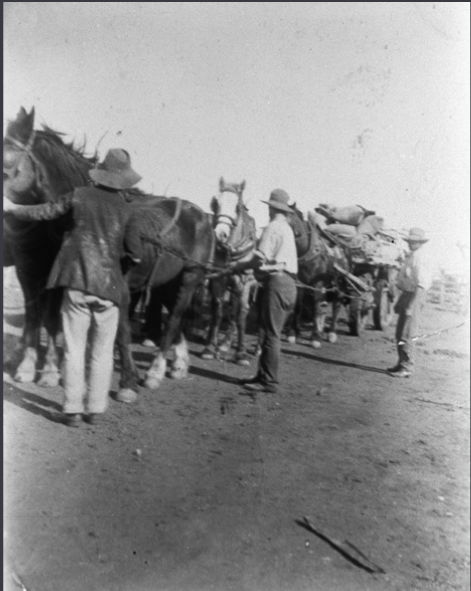
There would have been horses there when taken up too, as wild horses were in the area, so some probably caught and used.
Welbourn Hill ran cattle, so horses needed for mustering and droving the 100 or so miles to Oodnadatta to the train. They also sold excess horses, the India market being strong, as well as any local sales of horses; at social occasions such as the Oodnadatta race day people often traded, sold or bought the odd horse or two.
Image: Three men with a team of horses pulling heavily laden wagon near Oodnadatta c1920, photo by Frank Dunk, State Library of S.A.
Stock was taken to Oodnadatta then by train to Adelaide. One could drive via Quorn to Welbourn Hill, and onward to Alice Springs, a rough track but nonetheless used.
Alfred Giles was the first to take horses up through the Centre in big numbers, for breeding. It is more than likely the Welbourn Hill property had some of his bloodlines. He always chose his horses very wisely, from those already living on vast dry runs. He also liked Timor Ponies and had some in the Territory and possibly in South Australia. Don’t know if Alfred was related to John (Jack) and Phil (Phillip) Giles who had Welbourn Hill. He’d been exploring in S.A. and the N.T. with John Ross, on that expedition taking over 100 horses selected near Port Augusta. Both men knew a good horse for the job. These are thought to be the first lot of horses to the area. In 1871 Alfred took 5,000 sheep to feed those building the Overland Telegraph line, all the way from Adelaide to near Darwin. Soon after, with brother Arthur, both working for Dr Browne, they took stock to settle several of Browne’s stations – Newcastle Water, Springvale and Delamere. Thousands of sheep, cattle and horses, the horses all carefully selected. Alfred stayed on Springvale (NT) from 1879. So the Giles horses became legendary and the start of horses in the N.T. It is more than likely their bloodlines were on Welbourn Hill.
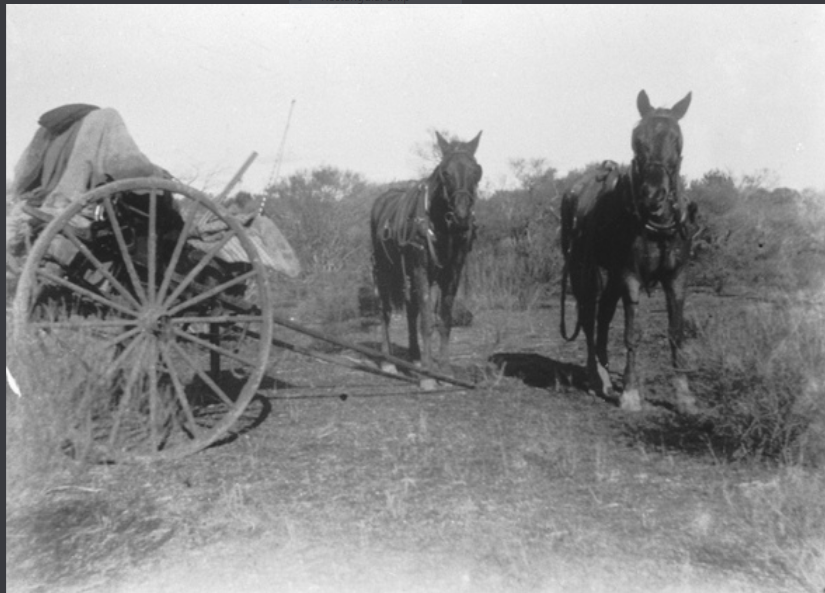
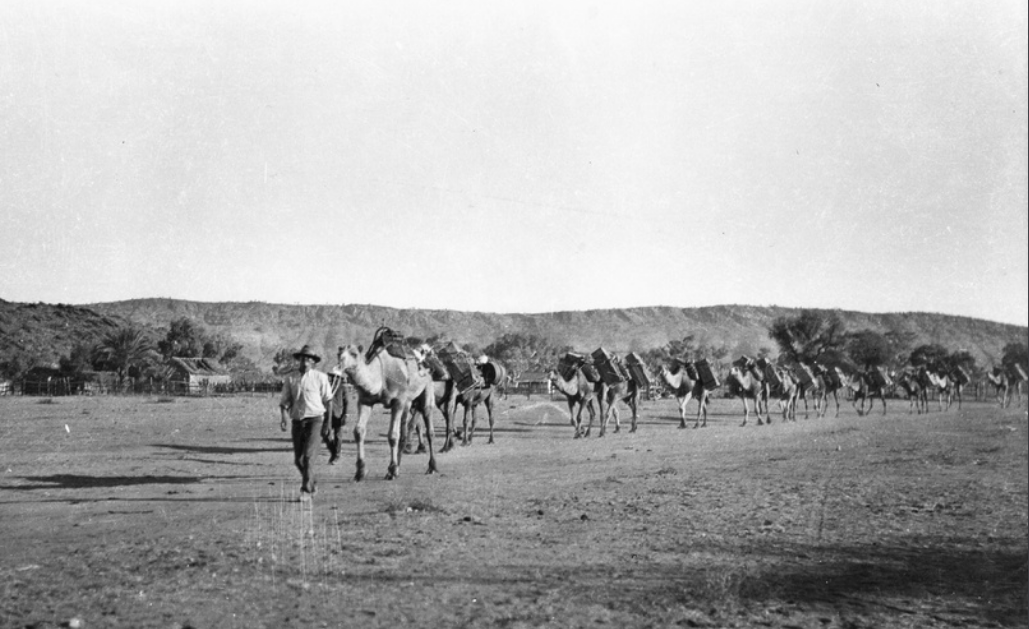
Photos by Jack Laver, 1924, State Library of S.A.: Sulky and tandem ponies used during a trip to the Oodnadatta area. c. 1920; Camel train returning from Oodnadatta with provisions, Bill Fox leading the team.
As well as (strong!) horses and riding camels, draught camels were used to pack supplies in and through the general area, usually from the train at Oodnadatta.
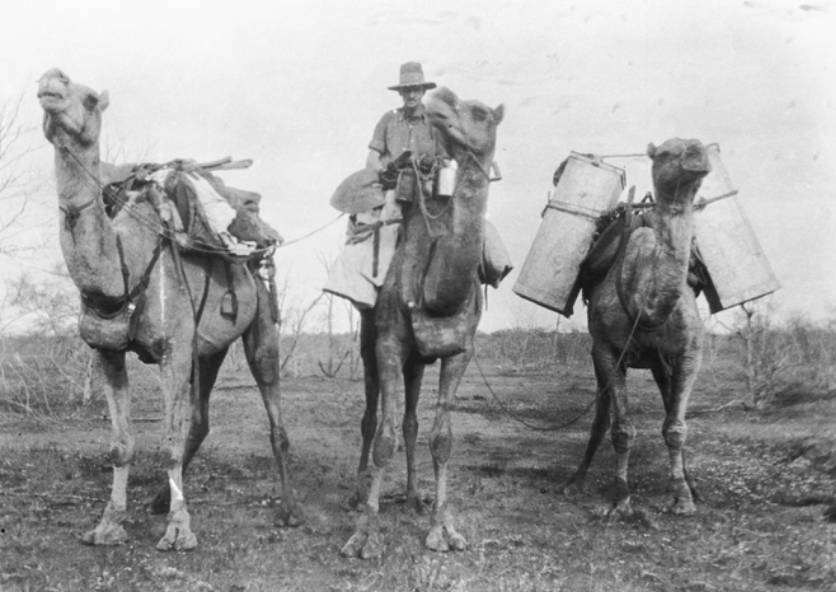
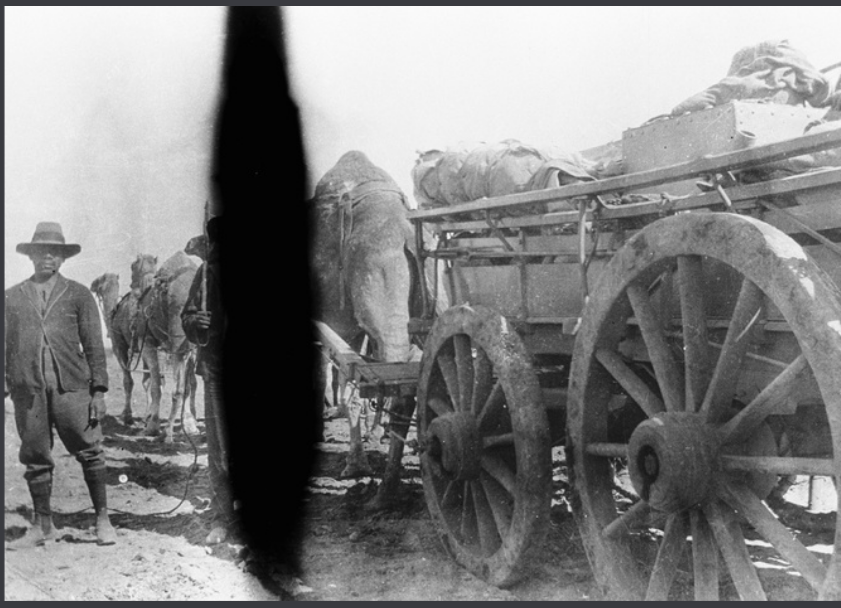
Images from State Library of S.A.: A male rider (Jack Giles) on a camel with two others carrying packing cases and other equipment, thought to be on Welbourn Hill Station. c. 1920; Camels pulling a wagon on Welbourn Hill Station, photo by J. Meagher
A few dates as appearing in newspapers…
1914 Mrs E. Giles sent cattle from Welbourn Hill to Adelaide via Oodnadatta.
In 1922 Mrs John Giles became the first white woman to live there. She and husband John (Jack) took 5 days to travel to Adelaide by motor car, over rough bush tracks. They stayed at Coober Pedy on the way, and at Coonamble Station. Coonamble was noted for its excellent horses. They sent cattle south to sell at intervals, taken through to Oodnadatta to be entrained to Adelaide. They sunk several wells and bores, in dry times these being the only water source in parts of the station. Mrs Giles had a beautiful garden full of flowers and fruit at the Station; it yielded many figs, oranges, mandarins, grapes, and tomatoes all year round. Jack had a good meat house to supply the family, staff, and local Aboriginal people with supplies. They had the well water near the house chemically tested and got drinking water from a well four miles away that was healthier.
1922 In this year Jack and Phil dissolved their partnership running the station, and Jack took it over alone. He had a very tough time until in 1927 his first lot of cattle arrived in fat condition and got excellent prices at the sales, previous drafts not being the best. There were big orange trees in the garden, said to be the best flavour anyone had ever tasted.
1923 Giles Bros. sending bullocks south to sell. Probably many other times too, just citing as they had to drove these on horseback across to Oodnadatta, then return home, so it says a lot for their horses.
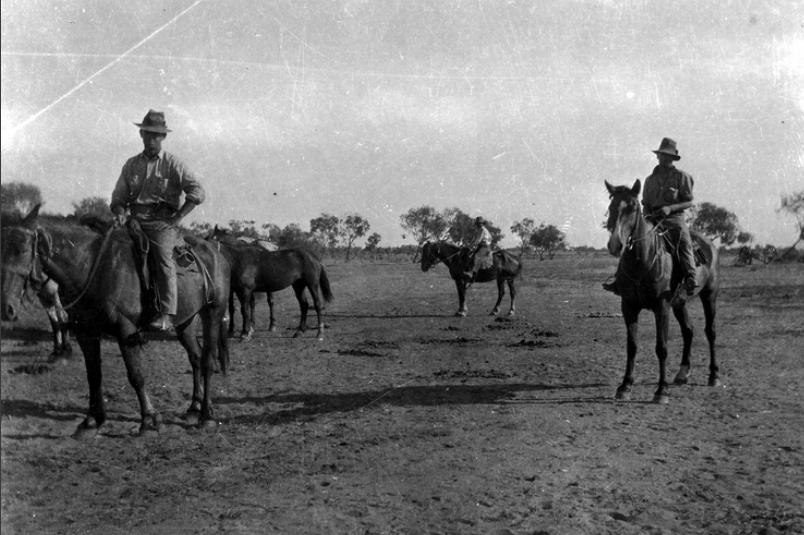
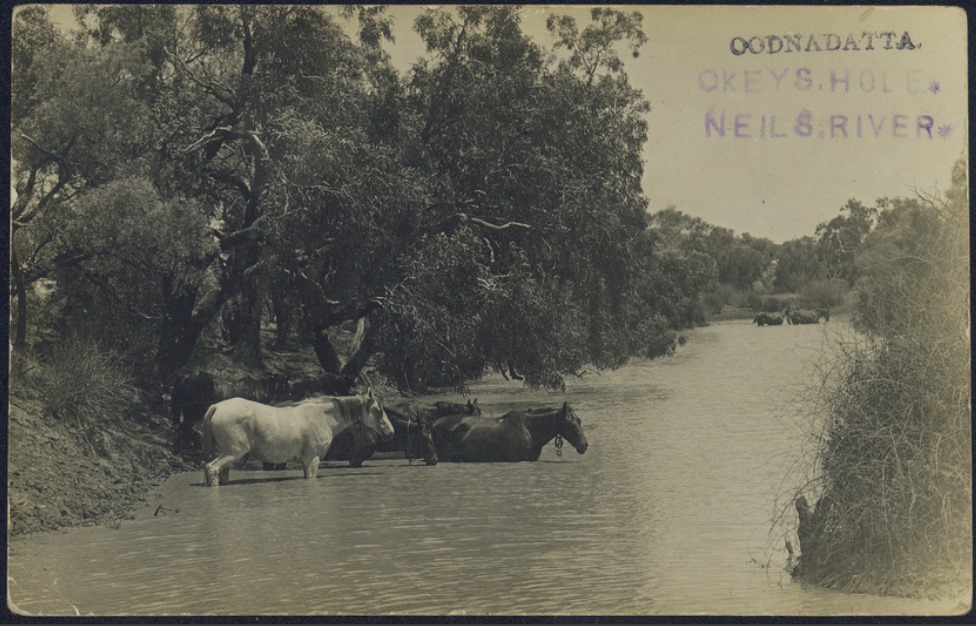
Images from State Library S.A.: Three stockmen and horses at Oodnadatta c. 1920, photo by J. Meagher; Horses near Oodnadatta
1925 Still no mail delivery to the stations of the area – Todmorden, Welbourn Hill, Indulkana, Lambina, Granite Downs, Mount Chandler, Ackeringa, Wintinna, Mount Willoughby and others. Government put out a tender notice for the 400 mile run that would take 3 days by motor, once a month. They got a tenderer. Bad drought that year, dead cattle and horses seen along the track from Oodnadatta by travellers, they reported Todmorden had gone from many thousands down to 3,000 cattle, not a living thing seen on Lambina not even birds; O’Donohue on Granite Downs was keeping 2,000 sheep alive out being shepherded in mobs of about 500. M Lennon was then running Indulkana and using Aboriginal women to man the bores with camels. At Welbourn Hill much praise for Jack and Phil, who were desperately trying to keep about 500 to 600 thin cattle alive, pumping water from a good bore put down in 1915, Marla bore. Having no rain for three years. Mr Underdown on Wintinna having a bad time: 5,000 cattle and 2,00 sheep, he was pulling mulga to feed horses and cattle, also 3 years with no rain. Before that he’d had abundant feed. There was a new permit system to find water on unoccupied Crown Land, and Larry O’Toole had just struck a good bore with good flow 11 miles east of Marla Bore.
1926 it took 32 hours to travel for his cattle to get from Oodnadatta to Adelaide, via Quorn. The hold up was after Quorn, thus the cattle arrived exhausted. They had to wait at several train stations, and the addition of sheep trucks slowed the train down to a crawl on upgrades.
1927 Jack went to the Pastoral Commission at Parliament House to give evidence about farming in that country. He had put in bores, but it only made a small portion of his leased property useable. Also he was firm friends with J. Pick of Coonamble, which had extra good horses, so some of that blood may have gone along to Welbourn Hill with Jack as purchases. Although Jack raced a few horses he’d bought after they failed for others, can’t find any of these being taken to the station. They were at Quorn and in Adelaide and can’t find any of them being registered either. More about his submission can be found here.
In 1927 Jack Giles complained to the government about the cattle trains from Oodnadatta, as they had no roof, boarded up sides, and the trip took 52 hours with hardly a break, so no water or feed was given. The cattle arrived poor and dazed and hard to handle. Any that went down could not be gotten back up during the trip. He’d lost about 800 cattle to drought and the ones sent to the sales were in good condition on leaving.
A traveller through the region in 1928, G.E. Archer Russell, a journalist, noted there were many wild horses in the entire area around Oodnadatta for hundreds of miles, and control was being done by shooting, some areas being totally shot out, others not.
1929 Jack got some sheep. Due to no fencing, he used shepherds to try and keep wild dogs off. However wild dogs plundered them somewhat, although his flock increased to 900, he sold off all but 30. Before long they’d increased to 300.
1933 Good rain August- September, Archaringa creek in flood so mail couldn’t get through. Tommy Cullinan was working there, he used to manage Anna Creek Station. He raced a horse named Transit in 1924-5 at Oakbank hurdles. A traveller amazed at the profusion of lemons and mandarins at the station.
In 1934-5 Ernestine Hill travelled through there, noting there was an excellent road through Lambina, Welbourn Hill and Mt Willoughby, and that all bred horses for the India market. Good rains 1935, Archaringa creek flooded two miles wide, luckily Jack had got his cattle through to Oodnadatta with stockmen but couldn’t get there himself to see them entrained.
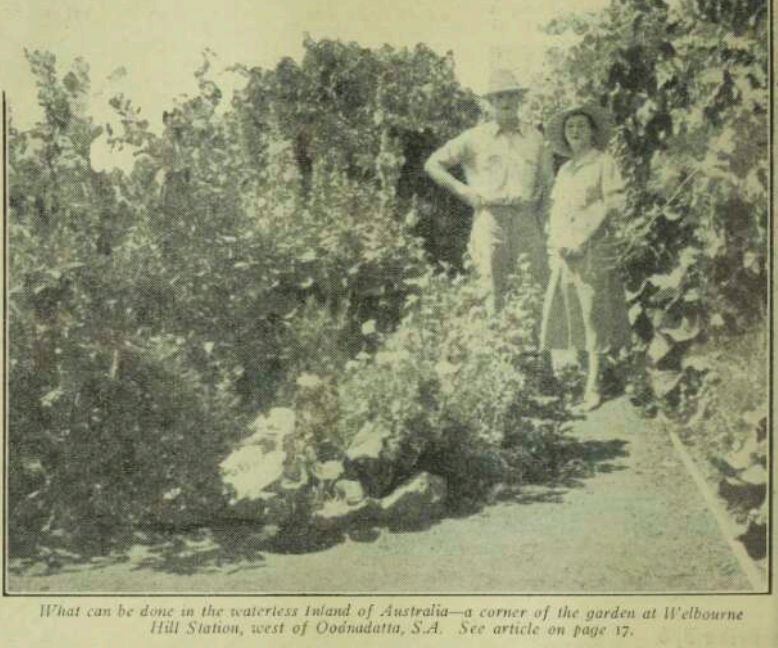
1940 At the yearling sales in Sydney, an agent bought a yearling Thoroughbred for Mrs jack Giles, it was a colt or filly (news reports say both) by Melfort out of Heroina. Herself a winner, and her first foal; it went by ship to Adelaide then to the stables of Mr Reid.
1942 Their cattle again highly praised at the sales. Mentioned the station was on a back track to Quorn. The station carried 1,500 head of cattle.
1943 Jim Robb found seven calves running with some of his cows had the Welbourn Hill brand. There was a court case. Giles denied knowledge and said the calves belonged to Robb.
In 1946 Phil Giles of Wintinna Station, bought it from his brother Jack Giles. Jack went to Adelaide to live. He’d been unwell, however recovered in the south and kept following his love of jumps racing, owning the horse Floodbird and having shares in others. Phil took cattle by train to Adelaide to sell. Jack got to Adelaide just before Christmas and got a telegram to say 3 inches of rain had fallen, so heavily it smashed up some outbuildings. There had been 11 months without rain, but plenty of dry feed. Phil Giles also raced horses in Adelaide such as Apostle and Best Vintage: trained at Quorn and travelled to Adelaide to race.
1949 Phil Giles had 6 runners in the Oodnadatta races, winning a first and some second placings.
1952 Mr W.E. Reick, Australia’s fastest shearer at the time, and his brother bought a lease neighbouring Welbourn Hill to run cattle.
1953 they sold Hereford-Shorthorn cross bullocks, steers and cows, top quality, big beasts, topped the sales. Phil’s sons raced Montparnasse and won a race.
1954 Phil Giles raced Best Vintage and Montparnasse at Balaclava. In that year was a severe drought for 100 miles around Oodnadatta including most of Welbourn Hill. Several stockmen shot brumbies to save feed and bore water for cattle. Further out had been rainstorms and the cattle were fat.
Summary: Welbourn Hill would have the best sort of horses of that area, indeed they were the best in Australia. The brumbies there are reported to be splendid (via a comment on our FB page, thank you). Hopefully some may be caught to carry on these lines, and be DNA tested to see their ancestry. The remote nature of the country has kept it genetically unpolluted, hopefully. Where there is a permanent garden in that country, there is permanent water, and that keeps horses alive.
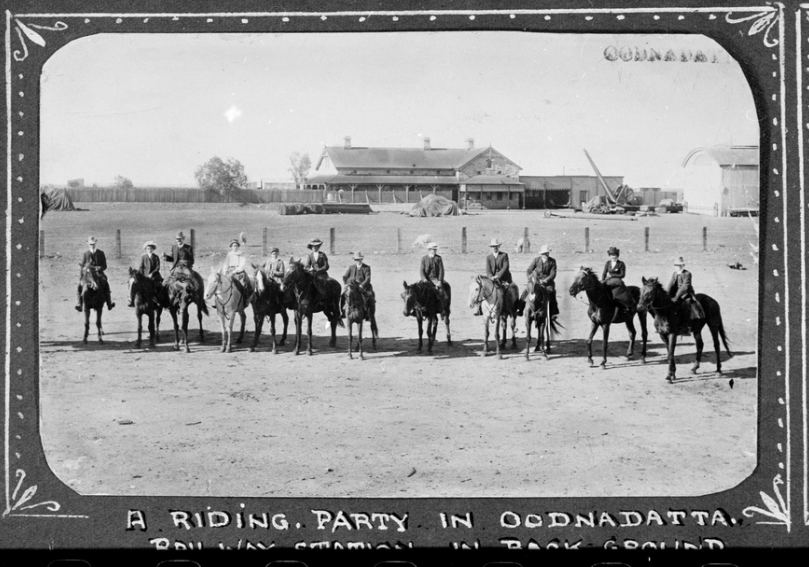
Below is a letter printed in the Observer (Adelaide), 26th November, 1926. One can see how the first horses got to the Territory and northern S.A.
MR. ALFRED GILES.
To the Editor.
Sir—In The Register on November 12 “Animbra” referred to my letter of a few days previous stating that Mr. Alfred Giles, who some time ago wrote a series of interesting and valuable articles in your paper, knew the Northern Territory better than any man living. “Animbra” says that Mr. Alec Ross has lived in and travelled about the Northern Territory for 40 or 60 years, and plainly suggests that Mr. Ross knows as much as, or more about, the Territory than Mr. Giles. I have since seen Mr. Alfred Giles, and he confirms what I already know to be a fact, that he (Mr. Giles) undoubtedly knows the Territory far and away better than any other man living. I say this without, for a moment, undervaluing Mr. A. Ross’s knowledge of the interior, which is no doubt very great. I may say that Mr. Alec Ross is a son of Mr. John Ross, who had command of the expedition of which Mr. Alfred Giles was second-in-command. When Mr. John Ross and Mr. Alfred Giles selected the horses for the proposed expedition from Port Augusta to Port Darwin, Mr. Alec Ross was a boy about 10 years of age, and I am glad, and so is Mr. A. Giles, that he is following in the worthy footsteps of his late father in trying to develop this great land. In passing, I may remark that the journeys and undertakings by Alec Ross have been done, comparatively speaking, with much more modern and up-to date equipment than Mr. Giles had in his time. Mr. Giles’s knowledge of central and more particularly of the north portion, of Northern Australia, extends from 1870 to the present time (about 55 years).
Mr. Giles left Adelaide in July 1870, to cross the continent from south to north. He was a member of absolutely the first party to do so after—just about eight years subsequently—J. McDouall Stuart’s great trip. Messrs. Ross and Giles’s first trip was for about 500 miles north of the, then, Mount Margaret Station, and considerably east of Stuart’s route. From that point they went due west, crossing Stuart’s track near central Mount Sturt, and returning to the Peake. The second trip was from a point about 150 miles north of where Barrow Creek Station now is; then they returned to the junction of the Finke and Hugh Rivers, where they met the first contingent of the overland telegraph construction party. From that point they went about 1,100 miles to the Roper River, and from there up to the Waterhouse River and thence across to Yam Creek. Mr. Giles says that on these trips he crossed the great MacDonnell Ranges five times, and on each occasion in a totally different gorge or place, and this was before Alice Creek was known or named. From Yam Creek they explored southwards down the Roper River, and then returned right to Port Darwin.
During 1871 and 1872 Mr. Giles was connected with the construction of the telegraph line and made many trips east and west of the line, principally searching for poles for construction. In 1872 he left Adelaide with 5,000 sheep and about 100 horses, taking them right through to Yam Creek (about 80 miles south of Darwin). In 1874, he returned right through to Beltana, with 5,000 for the telegraph stations and Government parties. During part of 1877 and 1878 he was continually travelling with a party between Alice Spring’s and Tennant’s Creek, repairing and re-erecting the wooden telegraph poles before the iron ones were brought to the line. At the end of 1878 he returned again overland to Adelaide. Mr. Giles, then, with his brother Arthur, started with 14,000 sheep, 4,000 cattle, and hundreds of horses to the Northern Territory for the late Dr. J. W. Brown, and formed the very first station in the Northern Territory, via Newcastle Waters, on the Katherine, where he stayed for 11 years, until the station was sold. He says that: Dr. J. W. Brown was undoubtedly the first pastoralist to open up the far-northern areas.
Most of the above facts I know from conversation with the late Hon. John Lewis and Alfred Giles, and letter and conversations with the late Roy Parkin Boucaut, who was associated with Lewis and Giles in the construction of the telegraph line to Port Darwin.
—I am, Sir, &c.,
HILLARY BOUCAUT.